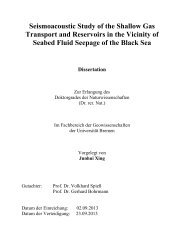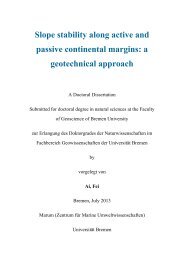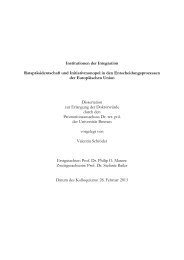aus dem MARUM und dem Fachbereich Geowissenschaften der ...
aus dem MARUM und dem Fachbereich Geowissenschaften der ...
aus dem MARUM und dem Fachbereich Geowissenschaften der ...
You also want an ePaper? Increase the reach of your titles
YUMPU automatically turns print PDFs into web optimized ePapers that Google loves.
MARIA S. MERIAN-Berichte, Cruise 20, Leg 4, Bridgetown – Freeport, 15.3.2012 – 7.4.2012<br />
gently sloping surface to the east. The first 3-5 km of the dipping slope east of the edge are<br />
covered by 20-40 m high, linear and steep-sided ridges that vary in length between 500-1000 m<br />
and trend in two directions; one is from NNE-SSW and the other NNW-SSE. The ridges often<br />
start at the same point, producing a series of V-shaped ridge sets. CWC form these ridges and<br />
ridge sets (see below). Interspersed between the ridges are smooth sediment bodies of 1-2 km<br />
diameter with similar thickness as the ridges (Fig. 6.5). These sediment bodies are steep-sided<br />
and often form a moat between the ridges (Fig. 6.6). Further to the east, the ridges give way to<br />
the smooth sediment cover that gently dips eastward.<br />
Fig. 6.3 PARASOUND profile across portion of the shelf north of Campeche Bank displaying eastward<br />
dipping seismic reflections that are truncated close to the sediment water interface. The unconformity<br />
is masked by extensive small transparent mo<strong>und</strong>s.<br />
Fig. 6.4 Oblique view (towards the north) of the Campeche Bank working area displaying the near flat<br />
submerged shelf and shelf edge with the adjacent slope that is covered by coral mo<strong>und</strong>s and further<br />
down-slope by fine-grained sediment. Inset A is a coral ridge location visited by the ROV and sampled.<br />
Inset B shows the two holes within the sediment cover that were sampled with the giant box corer.<br />
The PARASOUND data display a different seismic facies for each of the three morphologies<br />
(Fig. 6.5). The flat area is characterized by a strong top reflection(s) and a mostly transparent<br />
seismic facies below. It reflects the cemented nature of this part of the shelf. The strong<br />
reflection can be followed <strong>und</strong>erneath the sediment bodies and the ridges of the sloping area,<br />
19

















